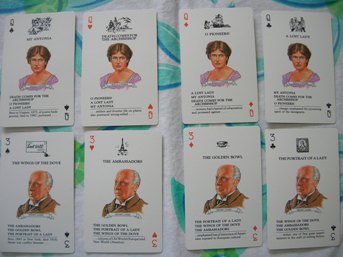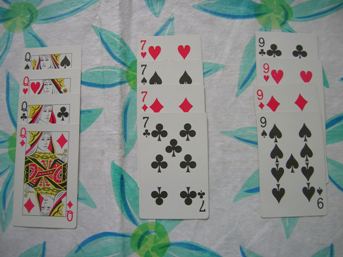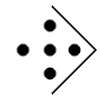
Authors started as a game with special cards with the names of famous authors and their pictures on them. Cards like these are still available, but many people play the game with a regular 52-card deck (Morehead and Mott-Smith 173). It was a popular educational game during the late 1800s, helping children to memorize the names and works of famous authors. Hofer describes a version from 1889 by the McLoughlin Brothers of New York which featured authors like Mark Twain and James Fennimore Cooper. The names of the authors and their works formed the "suits" of the cards (Hofer 66). The object is to create complete sets of works by a particular author. The picture to the right is from a modern set of commercially-made Authors cards.
The rules are basically the same as the rules for Happy Families, which is usually played with special cards with suits (often represented by different types of animals or people with certain professions - like the Baker, Smith, Cook, or Farmer families) made up of the members of different families including a mother, a father, a son, and a daughter. (The Diagram Group 308-309). In Happy Families, the object is to create complete sets of each family. Fish (also known as Go Fish) is a simpler form of the same game, where players make pairs instead of sets (Morehead and Mott-Smith 173).
Authors
The rules for this game come from Hoyle's Rules of Games ed. by Morehead and Mott-Smith, p. 173.
Players: 4 to 6 people (It's possible to play with 3, but it's better with more people.)
Object: To form sets of four cards of the same value.
The Deck: You can use a commercially-made set of cards specifically designed for the game, or you can use a regular 52-card deck.

Start by dealing all of the cards out to all of the players. It's okay if players don't have exactly the same number of cards in their hands. They study the cards in their hands and decide which cards they will need to form sets of four with the same value (Ex. seven of diamonds, seven of hearts, seven of spades, and seven of clubs). The sets of four cards are called "books."
Then, players take turns asking one of the other players for a certain card, going clockwise around the table. Players are only allowed to ask one player at a time for the card, and they must describe the card by both value and suit. For instance, a player can say, "Sarah, do you have the seven of diamonds?" but not "Do you have a seven?" Players are not allowed to ask for cards that they already have, and they must already have a card of the value that they ask for in their hand. For example, a player can't ask for a seven of diamonds unless he already has a seven from another suit.
Tip: Other players can guess what cards a person has in his hand by what he asks for and try to use it to their advantage.
Ex. If Joe asked Sarah for a seven of diamonds, the others know that he must already have another seven of some kind. So, if Amanda has the seven of hearts in her hand, she knows that Joe must have either the seven of spades or the seven of clubs (or both), and she can ask him for one of those on her next turn.
Having a good memory really helps in this game, and it's important to pay attention to what other people ask for and whether or not they get it.
If the other player has the card that the person asked for, that player gives it to the person asking for it. Whenever a player gets the card he asked for, he gets to ask for another card. (In the example above, if Amanda succeeds in getting the seven of clubs from Joe, she can also ask him for the seven of spades, and he would have to give it to her if he has it. If he tells her that he doesn't have the seven of clubs, she knows that he must have the seven of spades, but it won't help much because he now knows that she's holding a seven, and he'll probably ask her for it on his next turn.) The player's turn continues until someone doesn't have the card the player asked for.
When a player forms a book, he shows it to the other players and lays it down on the table. The game continues until all of the cards are in books. The winner is the person who forms the most books.

